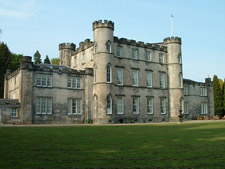WordPress database error: [Got error 28 from storage engine]
SELECT t.*, tt.*, tr.object_id FROM wp_terms AS t INNER JOIN wp_term_taxonomy AS tt ON tt.term_id = t.term_id INNER JOIN wp_term_relationships AS tr ON tr.term_taxonomy_id = tt.term_taxonomy_id WHERE tt.taxonomy IN ('category', 'post_tag', 'post_format') AND tr.object_id IN (5622, 19718) ORDER BY t.name ASC
Clan Melville History
The name Melville originates from Normandy, where Guillaume de Maleville was a companion of William, Duke of Normandy. Guillaume fought at the Battle of Hastings in 1066.
The family settled in Scotland during the reign of David I, where they were granted lands in Midlothian.
During the 12th century, under the reign of Malcolm IV, Galfrid de Maleville served as the ‘vicecomes’ of Edinburgh Castle. Later, under the reign of Wiliam the Lion, he became ‘Justiciary of Scotland’. Galfrids’ granddaughter Agnes was the sole heir to the Barony of Melville. She married John Ross of Halkhead, and her descendant was made Lord Ross by King James IV. The family then retained the Barony until 1705.
Galfrid de Malevilles’ youngest son Walter became the ancestor of the Melvilles of Raith.
In 1296, Sir John de Melville signed the ‘Ragman Roll’, thereby swearing allegiance to Edward I of England. His descendant was Sir John Melville of Raith, a favourite of King James V, being made Captain of Dunbar Castle and receiving lands at Murdocairnie in Fife. He was also an early supporter of the Reformation in Scotland, and knew some of those who conspired to kill Cardinal Beaton. He was falsely implicated in the murder by means of a forged letter and executed in 1550.
Sir John de Melville had two sons, John de Melville and Sir Robert Melville of Murdocairnie.
Sir Robert served under Mary Queen of Scots as the Keeper of the Palace of Linlithgow. Later he served as an ambassador in the court of Queen Elizabeth I, where he was protested Queen Mary’s death sentence, and was consequently threatened with imprisonment. He later became Vice-Chancellor of Scotland, taking the title ‘Lord Murdocairnie’. Later, in 1616 he was made Baron Melville of Monymail, and his son became Lord Monymail in 1627.
Robert Melville was succeeded by his cousin John, who was the third Lord Melville. John’s son was George Melville, who supported the unsuccessful rebellion of James, Duke of Monmouth. After the Duke’s execution, he fled to Holland, returning in 1688 with William and Mary of Orange. He was subsequently appointed Secretary of State for Scotland, later becoming President of the Council and the first Earl of Melville.
George Melville also inherited the title of the Earldom of Leven and the Castle of Balgonie in Fife when he married the granddaughter of the Covenanting General, Lady Catherine Leslie.
They had two sons, Alexander, the eldest, who died leaving no heirs, and David, who inherited the Earldom, and the title of ‘Lord Balgonie’.
In 1707 David Melville sat in the new Parliament at Westminster as a representative peer of Scotland, until 1710, later becoming a High Court Judge. David Melville was succeeded by his son David, who was fifth Earl of Melville and sixth Earl of Leven. He also had three other sons, one of whom died in 1777, in the American War of Independance.
The twelfth Earl of Melville served with the 2nd Dragoons (Scots Grays), fought and was wounded during the First World War. He later became a colonel in the Lovat Scouts, also Lord Lieutenant of Nairn, and eventually a Knight of the Thistle.
The present fourteenth Earl of Leven and thirteenth of Melville is Alexander Leslie-Leven. Sadly his eldest son, David Balgonie, died in a skiing accident in 2007.
The original family seat was Melville Castle in Lothian, but is now at Glenferness in Nairn.
Clan Melville Posts








